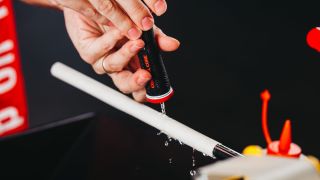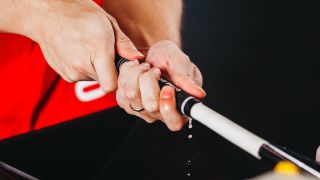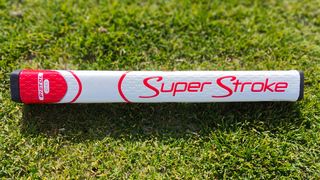How To Regrip Golf Clubs
Knowing how to regrip golf clubs makes it easier and more affordable to replace them as and when needed


As a golfer, learning how to regrip golf clubs is really valuable. While you might not think it, worn out grips can cost you precious shots, especially in damp and wet conditions.
Cleaning them often will help, but they do have a lifespan, and will eventually need replacing. However, for those who carry the full allotment of 14 clubs in their bag, cost can often be a major deterrent.
Do you go for a new set of grips or that new wedge you’ve had your eyes on? All too often it will go the way of the wedge. But changing a golf grip is easier than many golfers imagine. There will no doubt be subtle variations from pro shop to pro shop, but the basics haven’t changed much over the years.
How To Regrip Golf Clubs Yourself
You will need the following…
- New grips
- Double-sided tape
- White Spirit
- A sharp Stanley knife or similar
- A cloth
- A receptacle as long as a grip
- A vice with shaft protector
Step 1: Remove the old grips
First, cut or peel off the old grips, which may or may not be straightforward depending on how long they’ve been on. With steel shafts you can be relatively ‘aggressive’ with the knife, always making sure to work the blade away from you not towards you. (You may find it easiest to do this with the club secured in the vice.)
With graphite shafts, you must proceed more carefully to avoid damaging them. Ideally when cutting grips from a graphite shaft you should use a hook blade on your knife as opposed to a flat blade. This will prevent cutting into the graphite fibres.
Next you need to remove the old grip tape to prevent lumps and bumps forming underneath your new grip. If you’re lucky, a careful incision at the narrower end of the grip may allow you to peel off easily, but sometimes it will be a painstaking process that you have to carefully repeat as you pick off all the remnants of old grip and tape. It can be useful here to heat the old grip tape gently with a heat gun. This softens the adhesive and makes peeling tape off a lot easier. Take care not to overheat graphite shafts however.
Get the Golf Monthly Newsletter
Subscribe to the Golf Monthly newsletter to stay up to date with all the latest tour news, equipment news, reviews, head-to-heads and buyer’s guides from our team of experienced experts.
Dab the cloth in White Spirit and rub it up and down the shaft where the old grip was to clean off the final bits.
Step 2: Preparation

Next, hold the grip up against the shaft and with a washable marker pen, draw a small mark to signify the end point of the grip. This will provide a reference point for how far down the shaft to apply your grip tape and also for how far down to pull the grip when installing. This is important to ensure the grip will play its designed thickness. Stretching a grip will make it feel thinner.
Then, starting at the butt end, wrap the double-sided tape round the grip working downwards and allowing sufficient space so that it doesn't start overlapping lower down as the grip gets narrower.
You can also get double-sided tape in sheet form rather than on a reel. Leave a little extra at the top and don’t un-peel the other side of the tape until you are ready to fit the new grip.

Wrap the extra bit around the top so it is covered with tape as this will make it easier to slip the new grip on.

Step 3: Fitting the new grips
Place the club in the vice with the head pointing up, taking care to use a shaft protector (or similar) to avoid damage as you tighten. Now take one of the new grips, cover the little hole at the end, and pour in a little White Spirit. Cover both ends of the grip with your fingers and swill the White Spirit around so the whole of the inside is coated.
Place your receptacle under the grip (if your vice arrangement allows you to do so), then pour the White Spirit from the inside of the grip over the double-sided tape with any excess falling into your receptacle to re-use.

Take the grip and slide it on, making sure any alignment tweaks are done quickly, as there is a limited window in which you’ll be able to manoeuvre the grip. Ensure the bottom of your grip reaches the line you marked earlier.

Take it out of the vice and check it in the address position to make sure it’s correctly aligned, taking care not to damage the head on the ground. Give the butt of the grip a gentle tap on the floor to ensure the grip has gone all the way on and the grip cap is seated nicely on the end of the shaft.
If you’re quick enough, you’ll still be able to make final adjustments at this stage before it sets too firmly. Depending on how much lubricant you have used, generally your grips will be set and usable in around 30 minutes.

Repeat this process a further 13 times if you’re replacing a full set!
How to tell if you need new grips
There are a few tell tale signs that it might be time to regrip a golf club. Firstly, any indentations on the grip, usually around the thumb positions, are a good indication of a worn grip. This is simply where the rubber has actually been worn away by the friction of the hand movement during the swing.
Secondly, when a grip is shiny and slippy to the touch. If this is the case, it can have a detrimental effect on your grip pressure, causing you to hold on to the club too tightly. This can be addressed with some warm, soapy water and a scrubbing brush, but sometimes even this won't return the grips original tackiness. If that is the case, it's time for a change.
What size grip do I need?
Grip size is a very subjective area. Traditional schools of thought suggested that the correct grip size was one that allowed the finger tips of the top hand to lightly touch the fleshy pad of the thumb when holding the grip.

Bubba Watson uses up to 18 layers of tape to thicken his grips
Many top touring professionals do not subscribe to this theory however. Bubba Watson for example uses up to 18 additional layers of tape underneath his grips to achieve the thickness he wants, whereas Padraig Harrington has previously used no tape, and even stretched his grips to make them play as thin as possible. These two players both play the same glove size! Trial and error is the key here. Find out what feels and performs best for you.
What type of tape do I need to regrip my clubs?
There is no industry standard when it comes to grip tape. Generally speaking, any double sided adhesive tape will do the job. It should be noted that tapes can differ in thickness, so keep that in mind if you are looking for consistent thickness throughout your set. Most grip tape will come in 2" widths now to be used as a solid strip, however some people prefer thinner tape that spirals around the grip as this doesn't leave a seam.
How much does it cost to get one club regripped?
Prices can vary dramatically here, from as little as $3 for some budget options up to $30 for some of the best grips. Factor in that you may require up to 14 grips if you are intending to regrip your whole set including your putter grip.

Super Stroke putter grip
Some of the specialist, oversize putter grips can be even more expensive.
How soon can I use my clubs after regripping?
Depending on the amount of lubricant used, generally speaking you will be safe to use your clubs around 30 minutes after regripping. Using the clubs too soon after regripping can cause the grip to slip and misalign.

Joe has worked in the golf industry for nearly 20 years in a variety of roles. After a successful amateur career being involved in England squads at every age group, Joe completed his PGA degree qualification in 2014 as one of the top ten graduates in his training year and subsequently went on to become Head PGA Professional at Ryder Cup venue The Celtic Manor Resort. Equipment has always been a huge passion of Joe’s, and during his time at Celtic Manor, he headed up the National Fitting Centres for both Titleist and Taylormade. He’s excited to bring his knowledge of hardware to Golf Monthly in the form of equipment reviews and buying advice.
Joe lives in North Devon and still plays sporadically on the PGA West region circuit. His best round in recent years came earlier in 2023 where he managed a 9 under par 63 at Trevose GC in a Devon & Cornwall PGA Tournament.
Joe's current What's In The Bag?
Driver: Ping G430 Max 10K 9 degree - Fujikura Ventus Red 6X 45.75"
Fairway wood: TaylorMade Qi10 Tour - Mitsubishi Tensei 1K Pro White shaft 70TX 43.25"
Irons: Callaway Apex CB 24' 3-11 - Project X LS 6.5 shafts
Wedges: PXG Sugar Daddy 54 and 60 degree - Project X LS 6.0 shafts
Putter: Odyssey Toe Up #9
Ball: TaylorMade 2024 TP5x
-
 The Steps That Helped Me Go From Beginner To Single Figures In A Year
The Steps That Helped Me Go From Beginner To Single Figures In A YearHere's Jess Ratcliffe's plan of how she achieved her incredible handicap cut
By Jess Ratcliffe Published
-
 Report: Viktor Hovland Is LIV Golf’s ‘Next Target’
Report: Viktor Hovland Is LIV Golf’s ‘Next Target’The Norwegian has previously been highly critical of the PGA Tour's management but also denied he would move to the LIV Golf League
By Jonny Leighfield Published
-
 Why The Reaction To Jason Day’s Masters Clothing Is A Terrible Look For Golf
Why The Reaction To Jason Day’s Masters Clothing Is A Terrible Look For GolfIs there any sincerity to claims that we want to grow the game and be inclusive?
By Joe Ferguson Published
-
 What Is Avoda Golf? Check Out Bryson DeChambeau’s New Iron Brand
What Is Avoda Golf? Check Out Bryson DeChambeau’s New Iron BrandIntroduced at the Masters, the American revealed that he had put prototype irons from Avoda Golf in the bag for the event
By Matt Cradock Published
-
 Krank Golf: The Long Drive Brand Bryson DeChambeau Is Using At The Masters
Krank Golf: The Long Drive Brand Bryson DeChambeau Is Using At The MastersThe American sat at the top of the leaderboard following the first round of the Masters, with DeChambeau using a driver and fairway woods from an unfamiliar name
By Matt Cradock Published
-
 Why Data Is The Key To Knocking Shots Off Your Scores This Season
Why Data Is The Key To Knocking Shots Off Your Scores This SeasonEnhance your understanding of golf performance data and how you can use correctly it to lower your scores in 2024
By Golf Monthly Published
-
 5 Reasons Why Women Golfers Should Carry More Wedges
5 Reasons Why Women Golfers Should Carry More WedgesThey’re often referred to as the scoring clubs, yet many women only carry one or two of them. Carly Frost explains why adding more wedges to your bag will work wonders for your game
By Carly Frost Published
-
 5 Signs You Need New Golf Shoes
5 Signs You Need New Golf ShoesEven the best golf shoes wear over time. Here's the five signs it's time you invested in a new pair
By Dan Parker Published
-
 These Might Be The Coolest Nike Golf Shoes We've Ever Seen And Here's How To Get Them
These Might Be The Coolest Nike Golf Shoes We've Ever Seen And Here's How To Get ThemNike always produce special edition models near to big events and, at the 2024 Players Championship, the brand have delivered once again!
By Matt Cradock Published
-
 5 Things I'm Adding To My Golf Bag This Spring
5 Things I'm Adding To My Golf Bag This SpringWe're not far from the start of the golf season, and now is the best time to get your golf bag ready...
By Dan Parker Published